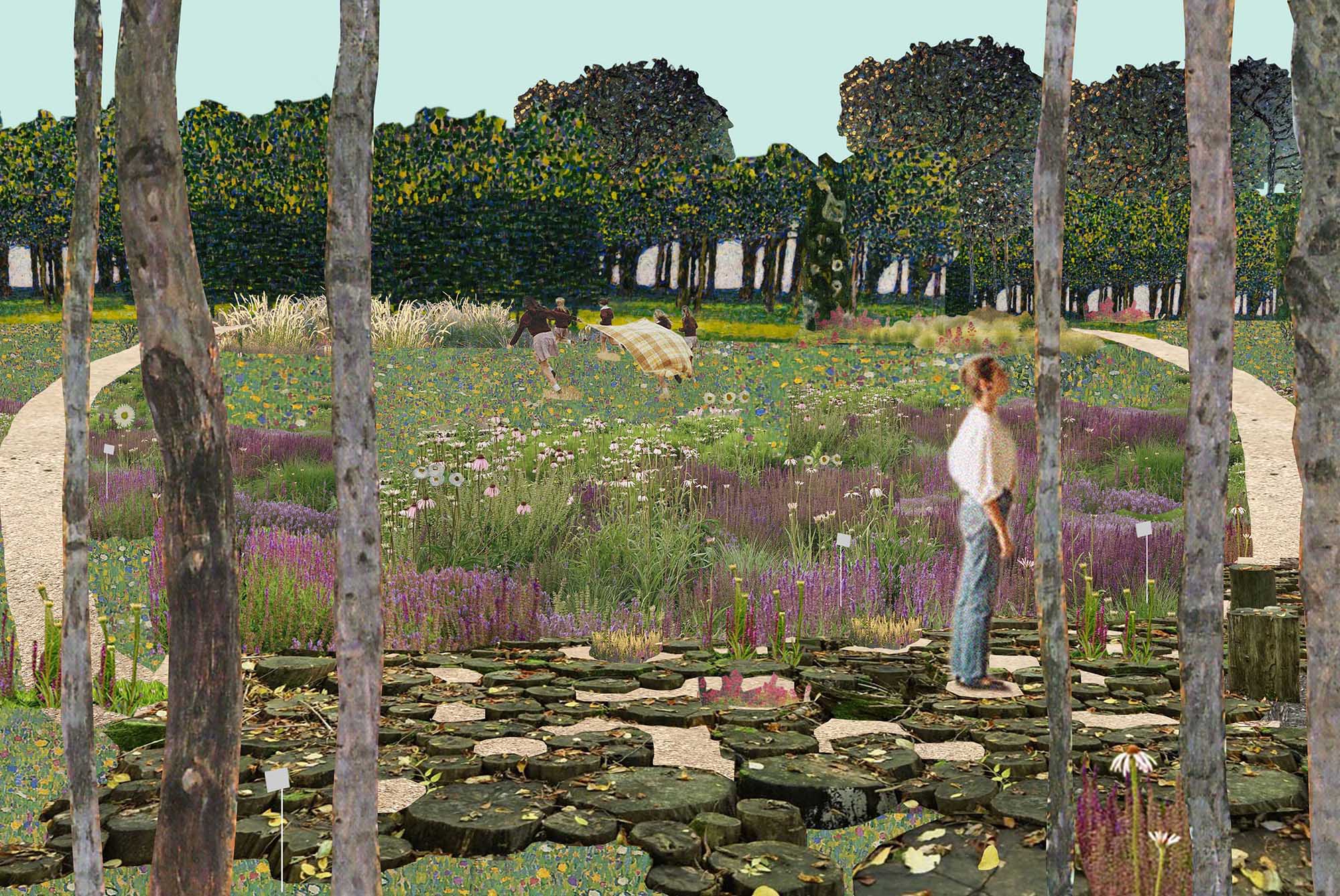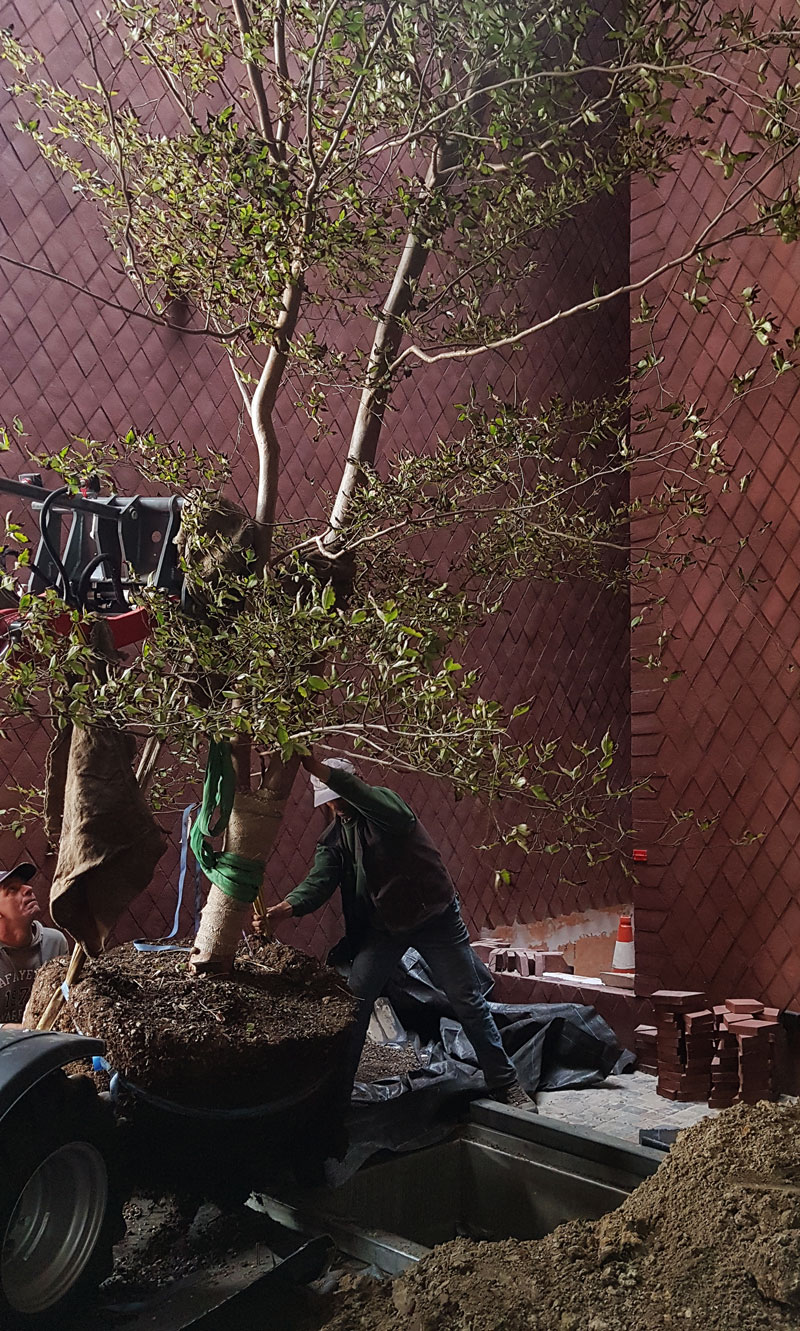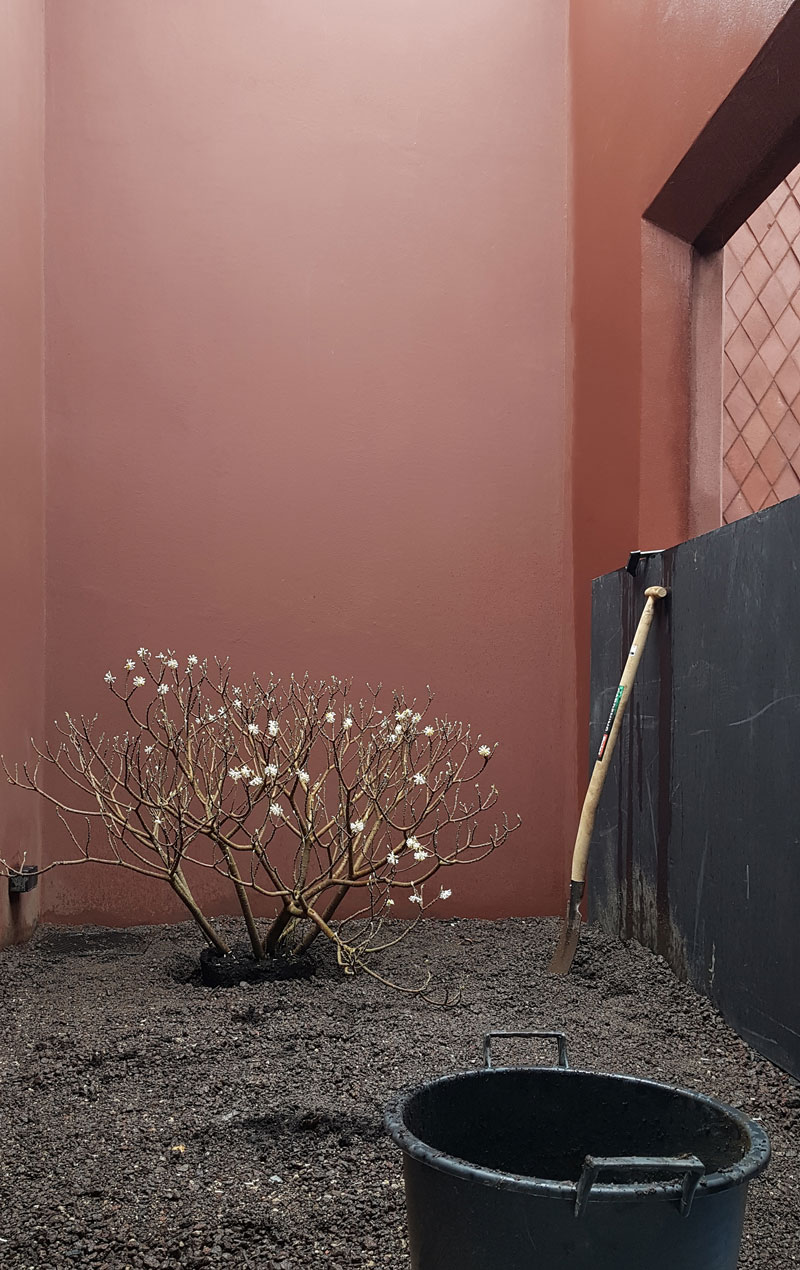
Oct. 24th, 2020
Designing [with] the Living
The Garden as the Place of Mystery
Text & images © Rebediani Scaccabarozzi Paesaggisti
“A garden is not an object but a process”
Ian Hamilton Finlay has managed to say a lot - perhaps everything - about the most intimate structure of gardens. Being able to see landscapes as sequences of events and recognising the processes that generated them are essential operations when designing them. It may take time, but both the creator and the keeper of a garden must always hold in mind that the object of their work is not an inactive matter that will be 'ready' in 2-3 years, but indeed a succession of interwoven scenarios that keep growing and evolving. Developing a garden is a conversation between the site, the context, the client, the plants, the sun, the shade and us. As landscape designers, our role is that of listening to the intertwining of all these stories - which are often only whispered - and then try to realise a project by expanding the character of the place.
A garden is not about us
Our gardens are very different from each other. We are not interested in building a 'recognisable sign'; we wish to give shape to a process full of meaning. We think in architectural terms - constructing basements, arches, vaults, portals and passages, arranging pauses, working in terms of perspective - and then add the element of time. It is not possible to build an arboreal vault, for instance, but it is possible to prepare the conditions for a series of processes that will lead to its constitution. For us, this becomes a cinematographic process, in which each plant is a flow of images, often seductive and in constant change. As Gertrude Stein says, “a rose is a rose is a rose is a rose,” but it is not the same the next morning. It is a matter of knowing - and having the ability to predict - the processes that will characterise each plant and its context. This is perhaps the main challenge and, at the same time, the charm of the work we do. It requires a large amount of time spent near the plants. To learn their cycles and to witness that, as much as they define an environment, plants are also shaped by it. This interdependent relationship structures the design experience. Working with living material, we cannot indulge in formal desires looking only at the aesthetic features of plants. We must welcome and dialogue with their functional and physiological needs too.
Ian Hamilton Finlay has managed to say a lot - perhaps everything - about the most intimate structure of gardens. Being able to see landscapes as sequences of events and recognising the processes that generated them are essential operations when designing them. It may take time, but both the creator and the keeper of a garden must always hold in mind that the object of their work is not an inactive matter that will be 'ready' in 2-3 years, but indeed a succession of interwoven scenarios that keep growing and evolving. Developing a garden is a conversation between the site, the context, the client, the plants, the sun, the shade and us. As landscape designers, our role is that of listening to the intertwining of all these stories - which are often only whispered - and then try to realise a project by expanding the character of the place.
A garden is not about us
Our gardens are very different from each other. We are not interested in building a 'recognisable sign'; we wish to give shape to a process full of meaning. We think in architectural terms - constructing basements, arches, vaults, portals and passages, arranging pauses, working in terms of perspective - and then add the element of time. It is not possible to build an arboreal vault, for instance, but it is possible to prepare the conditions for a series of processes that will lead to its constitution. For us, this becomes a cinematographic process, in which each plant is a flow of images, often seductive and in constant change. As Gertrude Stein says, “a rose is a rose is a rose is a rose,” but it is not the same the next morning. It is a matter of knowing - and having the ability to predict - the processes that will characterise each plant and its context. This is perhaps the main challenge and, at the same time, the charm of the work we do. It requires a large amount of time spent near the plants. To learn their cycles and to witness that, as much as they define an environment, plants are also shaped by it. This interdependent relationship structures the design experience. Working with living material, we cannot indulge in formal desires looking only at the aesthetic features of plants. We must welcome and dialogue with their functional and physiological needs too.


Collages: project for the new Botanical Garden of Bologna, competition by invitation (2019)
 Planting of Abraxa with the team of Space Caviar (2020)
Planting of Abraxa with the team of Space Caviar (2020)
The garden as a living archive
The characteristics of each context can be considered as design tools that influence the choice of plant species to be used; at the same time, such characteristics also determine the shape of the plants themselves. Take the case of shady environments: the vast majority of plants that grow there have very large leaves (which enable them to capture as much light radiation as possible), their foliar lamina is much thinner than those growing in sunny spots (as they need less 'protection' from direct radiation) and they have a deeper green shade because of the amount of chlorophyll they contain. For us, functional characteristics such as these constitute the basis of an archive that we can draw on to design and express the character of each new project site.
The archive becomes an interpretation tool that we can use to understand better the evolution of the gardens we conceive. It is essential to keep an open dialogue with those who live and take care of the sites, learning how plants react to the existing environmental conditions. It is crucial to understand if our predictions have come true and if clients have developed a relationship with the gardens. We need to keep track of all the growth phases. Just as an archive is created upstream of the project - from which we get inspiration - an archive is formed downstream, in which we collect all the data of the processes we triggered.
The characteristics of each context can be considered as design tools that influence the choice of plant species to be used; at the same time, such characteristics also determine the shape of the plants themselves. Take the case of shady environments: the vast majority of plants that grow there have very large leaves (which enable them to capture as much light radiation as possible), their foliar lamina is much thinner than those growing in sunny spots (as they need less 'protection' from direct radiation) and they have a deeper green shade because of the amount of chlorophyll they contain. For us, functional characteristics such as these constitute the basis of an archive that we can draw on to design and express the character of each new project site.
The archive becomes an interpretation tool that we can use to understand better the evolution of the gardens we conceive. It is essential to keep an open dialogue with those who live and take care of the sites, learning how plants react to the existing environmental conditions. It is crucial to understand if our predictions have come true and if clients have developed a relationship with the gardens. We need to keep track of all the growth phases. Just as an archive is created upstream of the project - from which we get inspiration - an archive is formed downstream, in which we collect all the data of the processes we triggered.
A garden must be attended
The archives that we conceive also become proof of the frequentation of the gardens, which, unlike natural environments, require constant care and observation. We must not forget that a garden exists only in relation to a person who takes care of it or enjoys its fruits. If such a relationship does not exist, we are in the presence of a different environment, no less significant, but different.
Designing a garden, therefore means creating a system of relationships that also include those between plants and people, of which the waiting for a flower or a perfume is an integral part. One of the tools we use to imagine and manage the relationship between the garden and those who will take care of it is the ‘maintenance plan’. It is a document that lists the various human interventions required to preserve the decided meanings over time, as well as the features of the seasonal cycle of the garden itself. At the same time, the document summarises our predictions regarding the changes and growth processes of the designed environment. But, as it always happens with living systems, the real evolution of a garden is very complex and full of surprises, even when one tries to make the most accurate forecasts.
A garden for Z33 - House of Contemporary Art
Among our recent projects that most embody these instances is that of the gardens of the new wing of the Z33 - House for Contemporary Art in Hasselt (Belgium), a building that features four open rooms that dialogue with the sky. These rooms are interior gardens. The exhibition programme of Z33 is characterised by temporary shows and public spaces that define a certain rhythm of visitor attendance. The same rhythm, therefore, also guided the choice of plants, which we juxtaposed to offer ever-changing scenarios.
We deemed it essential to conceive a garden that would establish an empathic relationship with the public, so that, visit after visit, people could fall in love with different elements: a perfume, a dishevelled flower, of a leaf defined by its bold architecture. This somehow creates a situation where visitors can feel nostalgic for the freshness of a flower that won't return until the next year. To design these scenarios, we looked at plants as processes rather than objects, and we intertwined these flows in changing gardens. Some plants recur in all four gardens and together highlight the spatial qualities of each of them, defining an organism characterised by its variety. The gardens are all brothers, but each with their own personality.
The archives that we conceive also become proof of the frequentation of the gardens, which, unlike natural environments, require constant care and observation. We must not forget that a garden exists only in relation to a person who takes care of it or enjoys its fruits. If such a relationship does not exist, we are in the presence of a different environment, no less significant, but different.
Designing a garden, therefore means creating a system of relationships that also include those between plants and people, of which the waiting for a flower or a perfume is an integral part. One of the tools we use to imagine and manage the relationship between the garden and those who will take care of it is the ‘maintenance plan’. It is a document that lists the various human interventions required to preserve the decided meanings over time, as well as the features of the seasonal cycle of the garden itself. At the same time, the document summarises our predictions regarding the changes and growth processes of the designed environment. But, as it always happens with living systems, the real evolution of a garden is very complex and full of surprises, even when one tries to make the most accurate forecasts.
A garden for Z33 - House of Contemporary Art
Among our recent projects that most embody these instances is that of the gardens of the new wing of the Z33 - House for Contemporary Art in Hasselt (Belgium), a building that features four open rooms that dialogue with the sky. These rooms are interior gardens. The exhibition programme of Z33 is characterised by temporary shows and public spaces that define a certain rhythm of visitor attendance. The same rhythm, therefore, also guided the choice of plants, which we juxtaposed to offer ever-changing scenarios.
We deemed it essential to conceive a garden that would establish an empathic relationship with the public, so that, visit after visit, people could fall in love with different elements: a perfume, a dishevelled flower, of a leaf defined by its bold architecture. This somehow creates a situation where visitors can feel nostalgic for the freshness of a flower that won't return until the next year. To design these scenarios, we looked at plants as processes rather than objects, and we intertwined these flows in changing gardens. Some plants recur in all four gardens and together highlight the spatial qualities of each of them, defining an organism characterised by its variety. The gardens are all brothers, but each with their own personality.


Planting of the Gardens of Z33 - House for Contemporary Art, Design, Architecture Hasselt (2020)
Reading suggestions
John Dixon Hunt, Nature Over Again. The Garden Art of Ian Hamilton Finlay, Reaktion Books, 2008
Julian Raxworthy, Overgrown. Practices Between Landscape Architecture & Gardening, MIT Press, 2018
Robert Pogue Harrison, Gardens: An Essay on the Human Condition, University of Chicago Pr, 2008
About the authors
Rebediani Scaccabarozzi Paesaggisti is a landscape architecture studio founded in 2018 in Milan by Lorenzo Rebediani and Vera Scaccabarozzi. The duo designs with living material by listening to its connection with the environment, its needs and desires, as well as by reading the interweaving of the ecological, aesthetic and cultural aspects of landscapes. vslr.it / @lorenzorebediani / @vera_scaccabarozzi